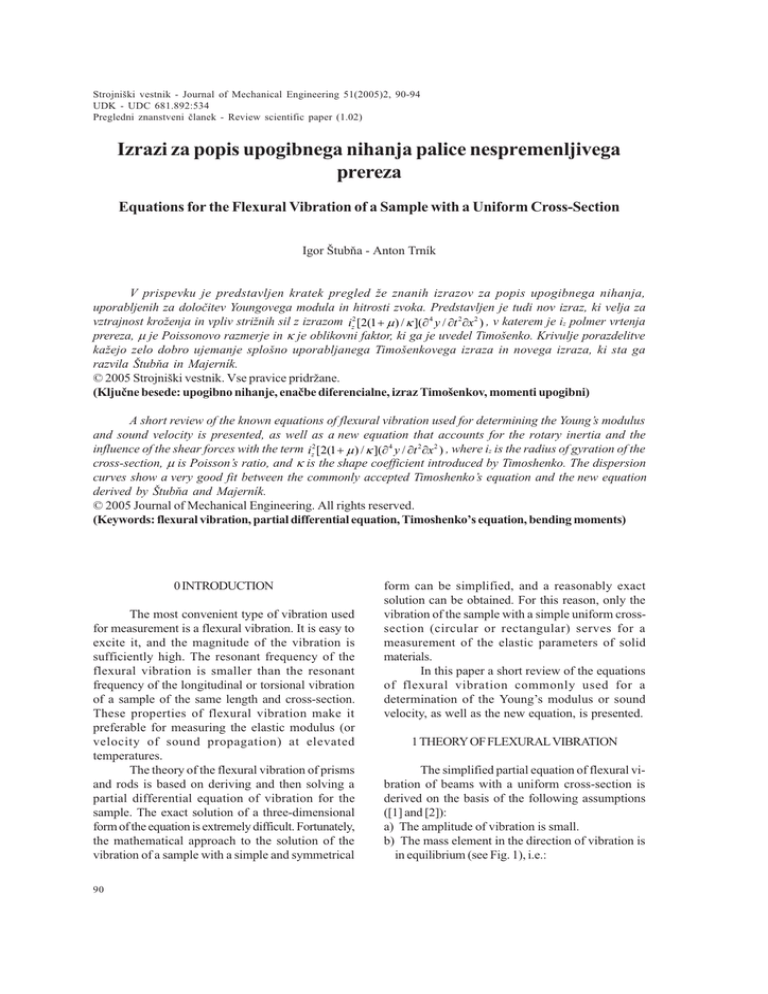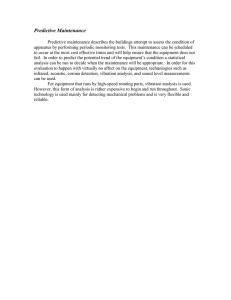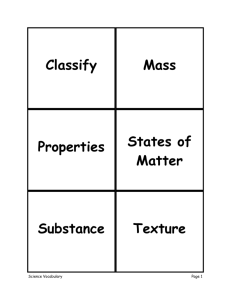
Strojniki vestnik - Journal of Mechanical Engineering 51(2005)2, 90-94
UDK - UDC 681.892:534Strojniki vestnik - Journal of Mechanical Engineering 51(2005)2, 90-94
Pregledni znanstveni èlanek - Review scientific paper (1.02)
Izrazi za popis upogibnega nihanja palice nespremenljivega
prereza
Equations for the Flexural Vibration of a Sample with a Uniform Cross-Section
Igor tubòa - Anton Trník
V prispevku je predstavljen kratek pregled e znanih izrazov za popis upogibnega nihanja,
uporabljenih za doloèitev Youngovega modula in hitrosti zvoka. Predstavljen je tudi nov izraz, ki velja za
vztrajnost kroenja in vpliv strinih sil z izrazom iz2 [2(1 + m ) / k ](¶ 4 y / ¶t 2 ¶x 2 ) , v katerem je iz polmer vrtenja
prereza, m je Poissonovo razmerje in k je oblikovni faktor, ki ga je uvedel Timoenko. Krivulje porazdelitve
kaejo zelo dobro ujemanje splono uporabljanega Timoenkovega izraza in novega izraza, ki sta ga
razvila tubòa in Majerník.
© 2005 Strojniki vestnik. Vse pravice pridrane.
(Kljuène besede: upogibno nihanje, enaèbe diferencialne, izraz Timoenkov, momenti upogibni)
A short review of the known equations of flexural vibration used for determining the Youngs modulus
and sound velocity is presented, as well as a new equation that accounts for the rotary inertia and the
influence of the shear forces with the term iz2 [2(1 + m ) / k ](¶ 4 y / ¶t 2 ¶x 2 ) , where iz is the radius of gyration of the
cross-section, m is Poissons ratio, and k is the shape coefficient introduced by Timoshenko. The dispersion
curves show a very good fit between the commonly accepted Timoshenkos equation and the new equation
derived by tubòa and Majerník.
© 2005 Journal of Mechanical Engineering. All rights reserved.
(Keywords: flexural vibration, partial differential equation, Timoshenkos equation, bending moments)
0 INTRODUCTION
The most convenient type of vibration used
for measurement is a flexural vibration. It is easy to
excite it, and the magnitude of the vibration is
sufficiently high. The resonant frequency of the
flexural vibration is smaller than the resonant
frequency of the longitudinal or torsional vibration
of a sample of the same length and cross-section.
These properties of flexural vibration make it
preferable for measuring the elastic modulus (or
velocity of sound propagation) at elevated
temperatures.
The theory of the flexural vibration of prisms
and rods is based on deriving and then solving a
partial differential equation of vibration for the
sample. The exact solution of a three-dimensional
form of the equation is extremely difficult. Fortunately,
the mathematical approach to the solution of the
vibration of a sample with a simple and symmetrical
90
form can be simplified, and a reasonably exact
solution can be obtained. For this reason, only the
vibration of the sample with a simple uniform crosssection (circular or rectangular) serves for a
measurement of the elastic parameters of solid
materials.
In this paper a short review of the equations
of flexural vibration commonly used for a
determination of the Youngs modulus or sound
velocity, as well as the new equation, is presented.
1 THEORY OF FLEXURAL VIBRATION
The simplified partial equation of flexural vibration of beams with a uniform cross-section is
derived on the basis of the following assumptions
([1] and [2]):
a) The amplitude of vibration is small.
b) The mass element in the direction of vibration is
in equilibrium (see Fig. 1), i.e.:
tubòa I. - Trník A.
Strojniki vestnik - Journal of Mechanical Engineering 51(2005)2, 90-94
y
dx
l
y
0
z
x
x
T+dT
M+dM
M
A
T
Fig. 1. Bending line, forces and moments effecting the mass element
r Sdx
¶2 y
¶T
dx
= (T + dT ) - T =
2
¶t
¶x
(1)
é æ x öù
y = ym exp ê jw ç t ± ÷ ú
ë è c øû
(5)
where r is the density of the beam material, S is
the area of the cross-section, T is the shear force,
t is time and x, y are coordinates.
c) The equation of the elastic line holds:
where j = -1 , w = 2p c / l is the angular frequency, c is the phase velocity of the flexural wave
and l is the wavelength. Substituting Eq. (5) into
Eq. (4) we obtain:
¶ 2y
= -M
¶ x2
c
æi ö
= 2p ç z ÷
c0
èlø
EJ
(2)
where M is the bending moment, E is the Youngs
modulus and J is the moment of inertia of the crosssection around the axis parallel with the z-axis.
d)The relationship between the shear force and the
bending moment has the form:
¶M
=T
¶x
(3).
Eliminating the shear force T from Eq. (1) with
the help of Eqs. (2) and (3) we obtain:
¶ 2y 2 2 ¶ 4y
+ c0 iz
=0
¶ t2
¶ x4
(4)
where c0 = E / r is the sound velocity (i.e., the
velocity of the longitudinal wave propagation in the
sample), iz = J / S is the radius of gyration of the
cross-section. Eq. (4) describes the vibrational motion of the sample with a sufficient exactness only
when the ratio l/d > 20, where l is the length of the
sample and d is the diameter of the cylindrical sample or thickness of the prismatic sample in the direction of vibration. The solution of Eq. (4) is the function:
(6).
In Eq. (4) we anticipated only a displacement
motion of the mass element in the direction of the yaxis. In the case of a fundamental mode vibration of
a short sample (in which l/d < 20) the rotation of the
mass element around the axis parallel with the z-axis
must be taken into account. The rotation of the mass
element must also be accounted for in the case l/d >
20 when the sample vibrates at a higher mode because the sample is divided into short parts by knots.
The rotary motion of the mass element is described
as (see Fig. 1):
r Jdx
¶ 2 æ ¶y ö
ç ÷=
¶t 2 è ¶x ø
= Tdx + M - ( M + dM ) = Tdx -
¶M
dx
¶x
(7).
If we derive Eq. (7) according to x and eliminate T and M by means of Eqs. (1) and (2) we obtain
an equation that includes the Rayleighs correction
(see e.g., [3]):
¶ 2 y 2 2 ¶ 4 y 2 ¶4 y
+ c0 iz
- iz 2 2 = 0
¶ t2
¶ x4
¶t ¶x
Izrazi za popis upogibnega nihanja - Equations for the Flexural Vibration
(8).
91
Strojniki vestnik - Journal of Mechanical Engineering 51(2005)2, 90-94
Substituting Eq. (5) into Eq. (8) we obtain:
c
æi ö
= 2p ç z ÷
c0
èlø
we obtain Timoshenkos equation [1] by the sequential elimination of the values of M, T, y and c:
1
(9).
2
æ iz ö
1 + 4p ç ÷
èlø
As we can see from Fig. 2, the curves of the
functions (6) and (9) correspond to the curve of function (15) only for a long wavelength.
Another step in the agreement between
theory and experiment was made by Timoshenko
[1], who proposed a correction for the effect of shear
forces. Timoshenko made a hypothesis according
to which the angle between the tangent to the elastic line and the x-axis is the sum:
¶ 2y 2 2 ¶ 4y 2
¶ 4y
i2 ¶ 4 y
+ c0 iz
- iz (1 + p) 2 2 + z 2 4 = 0
2
4
¶t
¶x
¶ x ¶ t k cs ¶ t
(13)
2
¶y
=y + c
¶x
where cs = G / r and p = 2(1 + m ) / k , and
where m = ( E / 2G ) - 1 is Poissons ratio.
Timoshenkos equation describes the flexural vibration of the sample with a circular or square crosssection very well and in accordance with experimental results. For samples with a different form of crosssection Pickett proposed equation [4]:
¶ 2y 2 2 ¶ 4y 2
¶ 4y
+
+
+
(1
)
c
i
i
p
z
0 z
¶ t2
¶ x4
¶ x 2¶ t 2
¶ 4y
i2 ¶ 4 y
+ (iz2 - i y2 ) 2 2 + z 2 4 = 0
¶ x ¶ t k cs ¶ t
(10)
where the angles y and c are connected with the
shear force and the bending moment according to:
T = SGkc and EJ
¶y
= -M
¶x
Eq. (14) transforms into Eq. (13) for a circular
or square cross-section. However, the influence of
the fourth term in Eq. (14) in the case of other crosssection shapes is very small. Substituting Eq. (5)
into Eq. (13) we obtain:
(11)
and the moment condition of the equilibrium of the
mass element is:
r Jdx
2
¶y
¶M
dx
= Tdx ¶t 2
¶x
c
1æ
4ö
= + çç A - A2 - ÷÷
c0
pø
2è
(12).
where:
In Eq. (11) G is the shear modulus of elasticity and k is a constant that depends on the shape of
the cross-section. From Eqs. (12), (11), (10) and (1)
æi ö
1 + 4p 2 (1 + p ) ç z ÷
èlø
A=
2
æi ö
4p 2 p ç z ÷
èlø
1
0,9
S
phase velocity/sound velocity
0,8
(14).
2
(15).
R
0,7
0,6
SM
0,5
T
K
K
0,4
0,3
0,2
0,1
0
0
0,1
0,2
0,3
0,4
0,5
0,6
0,7
0,8
0,9
1
radius of gyration/w avelength
Fig. 2. Disperse curves for the steel rod. S for simplified equation (6), R - for equation with Rayleigh´s
correction, Eq. (8), T for Timoshenko´s equation (13), K for Kuzmenko´s equation (16), SM for
equation derived by tubòa and Majerník (20)
92
tubòa I. - Trník A.
Strojniki vestnik - Journal of Mechanical Engineering 51(2005)2, 90-94
Fig. 2.
A curve calculated from Eq. (15) is shown in
From the analysis of Eq. (12) it is evident that
on its left-hand side there is only an angular acceleration coming from the bending moment, and on its
right-hand side there is a sum of all the moments of
the forces effecting the mass element. The total angular acceleration is given by Eq. (7). Kuzmenko used
Timoshenkos hypothesis (Eqs. (10) and (11)) together with Eqs. (7) and (1), [5]. Combining these
equations we get:
¶ 2y 2 2 ¶ 4y 2
¶ 4y
+
+
=0
(1
)
c
i
i
p
0 z
z
¶ t2
¶ x4
¶ x 2¶ t 2
as can be seen in Fig. 2. After substituting p into Eq.
(16) we obtain the equation:
1
(19)
2
æ iz ö
1 + 4p p ç ÷
èlø
which gives a result very close to the curve of Eq.
(15), see Fig. 2. We obtain the equation for phase
velocity (19) from the new equation derived by
tubòa and Majerník [6]:
2
¶ 2y 2 2 ¶ 4y 2
¶ 4y
+ c0 iz
- iz p 2 2 = 0
2
4
¶t
¶x
¶ x ¶t
y ( x, y ) = Y ( x)Q(t ) = [a sinh ax + b cosh ax +
(21)
+g sin bx + d cos bx]exp( jwt )
where:
a=
2
w
p
- +
2
c0
p 2 æ c0 ö
+ç
÷
4 è iz w ø
w
p
+ +
2
c0
p æ c0 ö
+ç
÷
4 è izw ø
(16)
and substituting Eq. (5) into Eq. (16) after mathematical modifications we obtain:
c
1
æi ö
= 2p ç z ÷
(17).
2
l
c0
è ø
æ iz ö
2
1 + 4p (1 + p) ç ÷
èlø
The result of Kuzmenkos attempt is shown
in Fig. 2. The values c/c0 for short wavelengths are
different from those calculated by means of Eq. (15).
The ratio c/c0 for the short wavelengths must approach the value cR/c0, where cR is the velocity of
the propagation of Rayleighs wave. For steel m =
0.29 and cR/c0 = 0.577, [2]. To fulfil the physical requirement c ® cR when l ® 0 , it is necessary to
change the coefficient from (1+p) in Eq. (17) to p.
Then:
c
2p (iz / l )
c
= R
lim = lim
(18),
2
2
l ®0 c
l ®0
c0
1 + 4p p (iz / l )
0
c
æi ö
= 2p ç z ÷
c0
èlø
which we obtain in the same way as Eq. (16) by using p instead of (1+p).
The solution for the differential equation of
flexural vibration (20) can also be written in the form
of a function of the type:
(20)
b=
2
2
(22)
The values for the bending moment and the
shear force are:
é d 2Y
w2 ù
M = - EJ ê 2 + Yp 2 ú exp( jwt )
c0 û
ë dx
(23)
é d Y dY
w ù
T = - EJ ê 3 +
(1 + p) 2 ú exp( jwt )
dx
dx
c0 û
ë
3
2
which together with the solution of Eq. (21) and its
derivation with respect to x make it possible to compile the frequency equation for given boundary
conditions.
2 CONCLUSION
The simplified Eq. (4) suffices for flexural
waves with a long wavelength (i/l < 0.03). For this
case Eqs. (8) and (16) give identical results, but they
are more complicated. For flexural waves with a
shorter wavelength (i/l > 0.03) Eq. (13) or Eq. (20)
must be used. The dispersion curves show a very
good agreement between the commonly accepted
Timoshenkos equation (13) and the new equation
(20) derived by tubòa and Majerník.
Acknowledgement
This work was supported by grant VEGA 1/0279/03.
Izrazi za popis upogibnega nihanja - Equations for the Flexural Vibration
93
Strojniki vestnik - Journal of Mechanical Engineering 51(2005)2, 90-94
3 REFERENCES
[1] Timoshenko, S. P. (1955) Vibration problems in engineering, D. Van Nostrand Co., New York 1955
[2] Brepta, R., M.Prokopec (1972) Propagation of mechanical waves and shocks in solid bodies. Academia,
Prague.
[3] Lamb, H. (1960) The dynamical theory of sound. Gos. izd. fiz-mat literatury, Moskva.
[4] Schreiber, E., O. Anderson, N. Soga (1973) Elastic constants and their measurement. McGraw-Hill Book
Co., New York.
[5] Kuzmenko, V. A. (1962) Zavodskaya Laboratoria, 28, No. 6, 726-731.
[6] tubòa, I., V. Majerník (1998) Acustica Acta Acustica, 84, No. 6, 999-1001.
Authors Address: Doc.Dr. Igor tubòa
Anton Trník
Constantine the Philosopher
University
Physics Department
A. Hlinku 1
SK-949 74 Nitra, Slovakia
istubna@ukf.sk
Prejeto:
Received:
94
12.2.2004
Sprejeto:
Accepted:
2.12.2004
tubòa I. - Trník A.
Odprto za diskusijo: 1 leto
Open for discussion: 1 year





